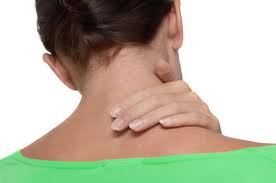I've had a few people ask me recently...what is myofascial pain?, in fact what does myofascial mean? And it's a very good question, as we are seeing it more and more in the clinic. Partly I think, due to the increase of stress in our lives.
So let me break down the word for you: Myofascia...Myo = Muscle, and Fascia = connective tissue, since you all know what muscles are lets talk  about fascia or connective tissue.
about fascia or connective tissue.
Connective tissue is often described as a thin almost translucent film that wraps around muscle tissue, I often use the visual of that filmy bit between the skin and the flesh when your peeling the skin off a chicken breast...(yes you all do it 'cause you're healthy eaters, right?).
But that's really only the start of connective tissue, it's much more 3D than between skin and muscle...it actually wraps around every muscle fibre, groups of muscles, around organs, even your spinal cord...it helps keep your body's shape by holding things in place. Oh and then there's the nerves and blood capillaries and veins that run through it too.
There are three layers of fascia too:
Superficial Fascia which is under the skin.
Deep Fascia is much tougher and denser and helps to separate your muscles and organs.
Sub Serous Fascia which is a loose tissue that covers your internal organs and hold networks of blood and lymph vessels that keeps them moist.
So generally when we talk about myofascia we are talking about the whole fascial system, and when we work with it with bodywork we may only be working on the superficial layers, but because it is so interconnected our bodywork can effect the deeper layers.
Another important feature of myofascia is ground substance, this material can change it's form from liquid to solid and back again (cool aye!) This can mean the difference of you feeling free and mobile or stiff and rigid like concrete. Ground substance can absorb forces when you move, or act as a shock absorber when it is in a gelatinous state when you are healthy. When it changes from a liquid to a gel then to a more solid form the myofascia tightens and it won't reverse without outside intervention such as massage or other bodywork.
This is why you can feel like "concrete' through your shoulders over time and often why you feel so much better after a massage because the myofascia (and ground substance) has softened.
So how does myofascia cause pain?
Well on several levels unfortunately...
1. Fibrous myofascial adhesions can form anywhere along nerves and block normal healthy function.
2. As you twist and turn so does your fascia and the more "stress" you put on your body the more "myofascial trains" can develop and these can restrict your movement.
3. Myofascia also forms what we know as scar tissue and this can be very restrictive to normal muscle function and can therefore create pain in the area but also in other areas.
4. Trigger points can also form in myofascia and muscles, and are one of the most common causes of musculoskeletal pain and often the most neglected in the medical world. Most of you who come into Balance Massage have had trigger points worked on and deactivated, for those of you who don't know what I'm talking about...
A trigger point is an extremely tender/sore point, often feeling like a taut band in the muscle. They often form in areas that have been under stress or constant load (poor posture is a common pre-cursor). Because the area is constantly contracted it limits the flow of blood and nutrients and also the removing of waste products and therefore irritates the area further, the trigger point responds to the emergency by sending out pain signals until the brain institutes a policy of rest for the muscle. When the muscle is no longer being used it begins to shorten and tighten...so it's a vicious circle. And then just to top it off trigger points can refer pain or sensation to other areas!
So, over time if left untreated or undiagnosed (which is common in the medical world), trigger points and myofascial pain can become chronic and have wide reaching effects in the body as it can mimic any sensation the nervous system can produce...which is why it gets misdiagnosed so often before being called Myofascial Pain Syndrome.
How to eliminate Myofascial Pain?
We recommend a holistic approach to manage the pain and then over time resolve the pain.
Massage therapy can be very effective in eliminating the trigger points but without a change in lifestyle, a commitment to retraining weak muscles, stretching tight muscles, increasing water intake, and reducing stress the trigger points will keep coming back. Often a team approach is needed, with GP's, acupuncture or dry needling, lymphatic drainage and other's such as chiropractic and Alexander Technique are important.
At Balance Massage we have the skills to help resolve your myofascial pain; whether it's relaxation massage to just start calming the parasympathetic nervous system down, or deep tissue massage, myofascial release work and trigger point work. We can also use dry needling to effectively eliminate trigger points and we have a good referral network to give you the support you need.
Call us today 378 0059 to book your sessions or find out more.
Reference:
Fibromyalgia & Chronic Myofascial Pain, second edition. Devin Starlanyl & Mary Ellen Copeland 2001









